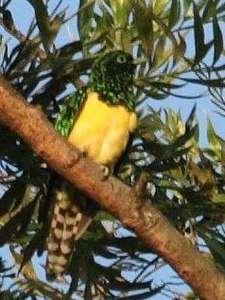African emerald cuckoo
The African emerald cuckoo (Chrysococcyx cupreus) is a species of cuckoo that is native to Africa.
| African emerald cuckoo | |
|---|---|
_in_tree.jpg) | |
| Male at St Lucia, KwaZulu-Natal | |
 | |
| Female at Eshowe, KwaZulu-Natal | |
| Scientific classification | |
| Kingdom: | Animalia |
| Phylum: | Chordata |
| Class: | Aves |
| Order: | Cuculiformes |
| Family: | Cuculidae |
| Genus: | Chrysococcyx |
| Species: | C. cupreus |
| Binomial name | |
| Chrysococcyx cupreus (Shaw, 1792) | |
Taxonomy and phylogeny
As a member of the Cuculidae genus, the African emerald cuckoo is an Old World cuckoo. There are four subspecies, namely C. c. cupreus, C. c. sharpei, C. c. intermedius, and C. c. insularum.[2][3]
Distribution
Its range covers most of sub-Saharan Africa, including Angola, Botswana, Burundi, Cameroon, Central African Republic, Republic of the Congo, DRC, Ivory Coast, Equatorial Guinea, Eritrea, Ethiopia, Gabon, Gambia, Ghana, Guinea, Guinea-Bissau, Kenya, Liberia, Malawi, Mali, Mozambique, Namibia, Nigeria, Rwanda, São Tomé and Príncipe, Senegal, Sierra Leone, South Africa, South Sudan, Swaziland, Tanzania, Togo, Uganda, Zambia, and Zimbabwe.
Description
The African emerald cuckoo is sexually dimorphic. The males have a green back and head with a yellow breast. Females are barred green and brown on their backs and green and white on their breasts. The African emerald cuckoo can also be identified by its call, a four-note whistle with the mnemonic device of “Hello Ju-dy.” [4]
 male in KwaZulu-Natal
male in KwaZulu-Natal_male.jpg) male, Ghana
male, Ghana_female.jpg) female, Ghana
female, Ghana_female_2.jpg) female, Ghana
female, Ghana
Diet
The cuckoo's diet consists many of insects like caterpillars and ants.[5] The diet can be supplemented with some fruit, and the African emerald cuckoo often forages in the middle and top layers of the canopy.[6]
Breeding
Like most cuckoos, the African emerald cuckoo is a brood parasite. Female African emerald cuckoos lay eggs in the nests of other bird species. A female cuckoo can lay between 19-25 eggs on average per breeding season.[7] The breeding season occurs during the rainy seasons, generally during the months between September and March.[4] Even though the cuckoo do not need territory (animal) to feed fledglings, male African emerald cuckoos still maintain a territory to display itself to potential mates.[4]
Conservation status and threats
The cuckoo's distribution is 11,400,000 km[4] across sub-Saharan Africa, and subsequently the species is not in any immediate threat of decline.[8] However, there is some concern about habitat reduction and fragmentation of riparian areas and lowland forests in the upcoming years.[6]
Folklore
In the Zigula language its call has been rendered as ziwkulwa tuoge, ("let's go and bathe"}. In Zulu it is known as ubantwanyana, or "little children", which suggests the song Bantwanyana! ning'endi!, or "Little children, don't get married!".[9] In Xhosa it is mostly known as intananja,[5] but its call is also rendered as ziph' iintombi?, meaning "where are the girls?"[9] In Afrikaans, it is known as the mooimeisie, or "pretty girl".[10]
References
| Wikispecies has information related to Chrysococcyx cupreus |
| Wikimedia Commons has media related to Chrysococcyx cupreus. |
- BirdLife International (2012). "Chrysococcyx cupreus". IUCN Red List of Threatened Species. Version 2013.2. International Union for Conservation of Nature. Retrieved 26 November 2013.
- "African Emerald Cuckoo Chrysococcyx cupreus (Shaw, 1792)". avibase.bsc-eoc.org. Avibase: The World Bird Database. Retrieved 12 October 2015.
- Payne, R. (2016). "African Emerald Cuckoo (Chrysococcyx cupreus)". Handbook of the Birds of the World Alive. Lynx Edicions, Barcelona. Retrieved 22 December 2016.
- Payne, R. "African Emerald Cuckoo (Chrysococcyx cupreus)".
- Johnson, Sibylle, African Emerald Cuckoo
- "Chrysococcyx cupreus (African emerald cuckoo , Emerald cuckoo)".
- Payne, Robert B. The Cuckoos.
- Ekstrom, J. "African Emerald Cuckoo Chrysococcyx cupreus".
- Godfrey, Rev. Robert (1941). Birdlore of the Eastern Cape Province (Bantu Studies Monograph Series, No. 2) (PDF). Johannesburg: Witwatersrand University Press. p. 57.
- Sinclair, Ian. Voëls van Suider-Afrika. Struik. ISBN 1-86825-197-7.
External links
- African emerald cuckoo - Species text in The Atlas of Southern African Birds.
